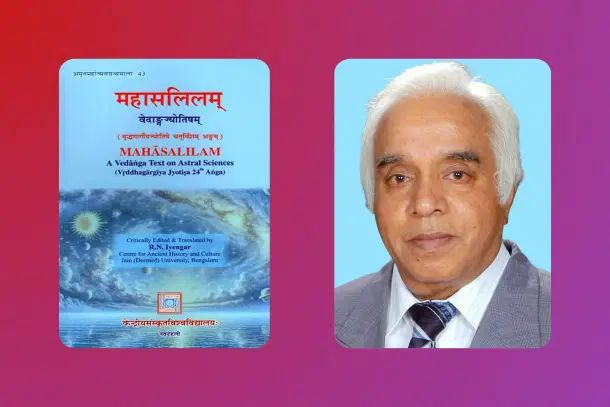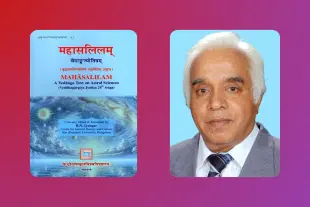Books
Before Space Science, There Was Mahāsalilam: Rediscovery Of India's Oldest Astronomical Text
R S Hariharan
Nov 02, 2025, 07:00 AM | Updated Nov 01, 2025, 11:49 AM IST
Save & read from anywhere!
Bookmark stories for easy access on any device or the Swarajya app.


Mahāsalilam – A Vedāṅga Text on Astral Sciences (Vṛddhagārgīya Jyotiṣa 24th Aṅga). Prof. R N Iyengar. Central Sanskrit University. Pages: 321.
When the Chairman of ISRO releases a Sanskrit book, it is safe to assume the subject reaches for the stars, literally.
On 28 December 2024, at Bengaluru’s Mythic Society, Dr S Somanath, head of India’s space programme, unveiled Mahāsalilam – A Vedāṅga Text on Astral Sciences, edited and translated by Prof. R N Iyengar and published by the Central Sanskrit University, New Delhi.
Also present was Dr Shrinivasa Varakhedi, Vice-Chancellor of the university. The occasion itself symbolised a continuum, where India’s most ancient sky-watchers met their modern successors.
A Lost Text Rises from the Depths
The Mahāsalilam forms the twenty-fourth Aṅga of the Vṛddhagārgīya Jyotiṣa, a monumental pre-Siddhāntic compendium attributed to the sage Vṛddha Garga. For centuries, this portion was thought lost, known only through scattered citations. Now, after collating eleven manuscripts from libraries across India and abroad, Iyengar has resurrected it in a critical edition, complete with translation and commentary.
The title itself carries cosmic poetry. Salila means water, but here it signifies the primordial fluidic darkness (andhaṁ-tamaḥ) from which all creation emerged. In modern terms, it evokes the idea of dark matter, the unseen matrix that births light. The Mahāsalilam is not merely about the heavens; it is about the first stirrings of the universe.
The Sages Who Asked Everything
Composed as a dialogue between Maharṣi Viśvāmitra and Maharṣi Vṛddha Garga, the text unfolds through a series of nearly a hundred profound questions. Viśvāmitra asks what any scientist might ask today.
How did the sky, the earth, and the oceans come into being? Why do the stars move? What causes eclipses, lightning, rain, and time itself?
Vṛddha Garga’s responses weave physics and metaphysics seamlessly. He speaks of a cosmic egg splitting into sky and earth, of the Sun and Moon moving around Meru, and of the 108 celestial bodies, seven visible planets and 101 ketus or comets, each governed by its own rays and rhythms.
The Mahāsalilam even quantifies brightness and motion, outlining the earliest empirical observations of the five visible planets, the six-monthly lunar eclipse cycle, and the concept of pūrṇatithi, the precise instant of the full moon.
The Oldest Science Text in the World?
Dating the Mahāsalilam pushes Indian scientific chronology deep into pre-history. Internal astronomical markers, which Iyengar argues identify it with the Maghādī era (around 1800–1600 BCE), show that the summer solstice aligned with the Maghā constellation, centuries before Lagadha’s Vedāṅga-Jyotiṣa established the later Śrāviṣṭhādī calendar.
In these passages, we glimpse a civilisation already measuring time in five-year Yuga cycles, mapping the Sun’s ayana or solstitial motion, and distinguishing fixed and moving celestial coordinates. If Lagadha’s text represents the classical codification of Indian astronomy, Mahāsalilam is its embryonic origin.
Iyengar’s Remarkable Reconstruction
Iyengar, formerly of the Indian Institute of Science and now Distinguished Professor and Mentor of the Centre for Ancient History and Culture at Jain University, is uniquely positioned for such work, being a trained engineer, seismologist, and Sanskritist in one.
His earlier Parāśaratantra (2013) had already demonstrated that ancient Indian scientists systematically recorded comets, eclipses, and planetary periods long before their supposed borrowing from Babylon or Greece. Mahāsalilam takes that argument further back in time.
His methodology is rigorous, cross-checking the Sanskrit with archaic astronomical data and aligning textual cues with verifiable celestial events. The result is a synthesis of philology and astrophysics, a blend that few scholars in the world could attempt.
From Philosophy to Observation
One of the text’s delights is its refusal to separate wonder from measurement. The cosmos is at once divine and quantifiable.
When Vṛddha Garga describes the Sun’s motion creating day and night, or the Moon’s waxing and waning in groups of five nights each, he is describing observation.
When he says, “Time (kāla) is the root cause of all celestial motions,” he is offering theory.
Here is an intellectual world where science was sacred, not opposed to spirit. The Mahāsalilam stands as perhaps the first document where nature’s cycles, human ritual, and cosmic order are treated as one continuous reality.
The Book Itself
The edition, printed by the Rashtriya Sanskrit Sansthan (now Central Sanskrit University), is a scholar’s delight.
It opens with a Foreword by Padma Shri Prof. M. D. Srinivas, situating the text in the long arc of Indian astronomy from the Vedas to the Siddhāntas.
A Sanskrit Purovāk by Prof. Veeranarayana N. K. Pandurangi frames the philosophical intent.
Iyengar’s own introduction, spanning two analytical chapters, reads like an intellectual detective story: how the scattered manuscripts were compared, how variant readings were restored, and how each technical term was reinterpreted in the light of both Vedic usage and modern astronomy.
The translation is lucid and restrained, letting the text speak. Each section carries brief but insightful notes explaining the astronomical or linguistic context. Despite the density of material, the book remains accessible to readers from either tradition, scientific or Sanskritic.
Why This Matters
Mahāsalilam reopens a civilisational conversation about India’s place in the history of science. For too long, the narrative of ancient astronomy has been written from the outside, viewing Indian achievements as borrowings from Babylonian or Greek models.
Iyengar’s work decisively challenges that. The five-year Yuga, solar–lunar ayanas, comet catalogues, and polar-star observations described here belong unmistakably to the Indian sky and psyche.
This is not chauvinism; it is reclamation based on evidence. In recognising the Mahāsalilam as the earliest Jyotiṣāṅga, the limb of the Vedas dealing with the lights of heaven, India asserts continuity, not imitation.
A Living Continuum
That the Chairman of ISRO chose to launch this monograph is symbolically perfect. The same civilisation that once saw Abhaya Dhruva (Thuban) as its pole star now navigates space with satellites and telescopes.
Between those two eras runs an unbroken curiosity about the cosmos, a lineage of observation, reflection, and reverence.
In that sense, Mahāsalilam is not an archaeological find; it is a reminder.
It tells us that the search for truth, whether through mantras or mathematics, has always been part of India’s civilisational DNA.
In the End
Iyengar’s Mahāsalilam is more than a critical edition; it is a bridge between epochs.
By reviving a Vedic text that viewed time, nature, and consciousness as one vast ocean of causation, he gives modern readers a rare gift: the awareness that science and philosophy once shared the same sky.
If the stars have stories to tell, Mahāsalilam is their oldest surviving script.
R S Hariharan has a background in science and technology with experience in research, linguistics, and industry. His work explores Sanskrit literature and India’s civilisational and scientific thought.





